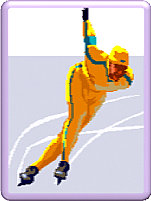|
EQUIPMENT:
Necessary Equipment For Speed Skating Participation:
All skaters require protective equipment to participate in our speed skating programs. The protective equipment must
be worn at every practice. The following table outlines the equipment required and any differences between the different
programs. If you are interested in buying boots or blades, please discuss this with your coach before making any purchases.
The coaching staff will make recommendations regarding equipment, but it is the responsibility of the skater and their
parents to ensure that they have the appropriate safety equipment for practices and competitions. If you are in doubt, select
the safest equipment.
To see how it all fits together, why not check out the photos at the Southern California Speed Skating Association?
Item Specifications:
Helmet Protective headgear must be worn by all participants. For younger skaters in Novice or Development, a hockey helmet,
rollerblading helmet, or bike helmet can be used. For skaters in the Competitive program, however, specifically designed
speed skating helmets meeting the ASTM standard must be used. SSC and ISU rules state that these helmets must be worn in
all SSC or ISU sanctioned meets. These are relatively expensive ($50-75), but they provide great protection and one size
fits all. This means that if you purchase one when your child is young, it will grow with them as long as they look after
it. LAS and Louis Garneau both offer acceptable helmets. They can be ordered over the Internet or occasionally group purchases
are arranged.
Eye protection It is strongly recommended that Novice skaters wear face protection in the form of a mask. This is not
possible with helmets other than hockey helmets. Once skaters are in a group with long blades, it is strongly recommended
that skaters wear eye protection in the form of goggles certified for racquetball sports (available at most sports stores).
Any eyewear worn by skaters must be held on the head with a strap. These are required to compete in Quebec, according to
Quebec rules.
Knee pads - Knee pads are required for all skaters. Soft volleyball-style knee pads or speed skating knee pads are preferred.
Skaters in Novice can wear roller balding knee pads but the hard casing gets in the way as skaters progress.
Shin pads - Shin pads are obligatory. Hard plastic soccer shin pads available at any sports store or Canadian Tire are
acceptable. They should be worn under the clothes. Do not purchase soft shin pads or shin pads with the hard plastic in
strips. Hockey shin pads do not work.
Cut resistant gloves - Cut resistant gloves must be worn. Padded ski gloves (for younger skaters), leather gloves, or
Kevlar speed skating gloves are acceptable. Kevlar lined leather gloves are the best. Wool, cotton or nylon are not acceptable.
Leather gloves can be purchased at stores like Mark's Work Warehouse or special speed skating gloves can be purchased through
the Internet or regional dealers.
Bib style neck guard Bib style neck guards are required. A neck protector will keep the neck are protected when falling.
They must be cut resistant, made of ballistic nylon, and must cover the neck and upper chest area. They can be purchased
at any sports store selling hockey equipment.
Elbow pads - Elbow pads are strongly recommended for the Novice speed skating program --- these skaters tend to fall on
their elbows. Hockey or rollerblading elbow pads are both fine. Older skaters do not need them.
Clothing - For Novice skaters, warm, stretchy clothing is best. Nylon wind pants will help keep skaters dry. Skaters
in the Development program should wear stretchy clothing such as a track suit or sweat pants. Long sleeves are always mandatory.
Wind suits in the Development program tend to be too warm for skaters and catch too much wind. In the Competitive program,
skaters generally wear some form of lycra or spandex skin suit and a long sleeved t-shirt in practices. Full skin suits are
worn in competition. If you are wondering what is best to wear, watch or talk to some of the older skaters. Frequently,
second-hand skin suits can be purchased or else a group will order skin suits together from one of the manufacturers in Canada.
Skates - For the Novice program and the first level Development program, hockey skates are acceptable. As skaters move
up in the program, they must move to long blades or they will fall behind the other skaters and not be able to participate
fully. The decision to move to long blades is usually made at the instigation of the child. If you want to move to long
blades, please discuss it with your coach. You may purchase your own skates or skates are available to rent from the club.
If you are interested in purchasing long track skates or blades, discuss this with your coach.
|

